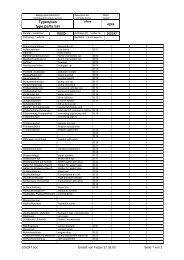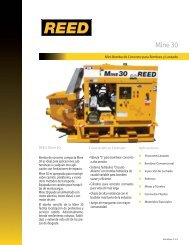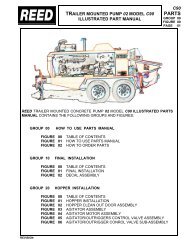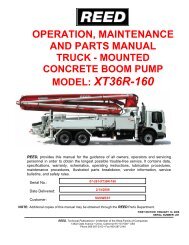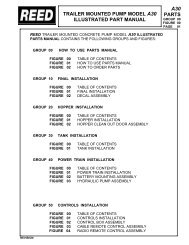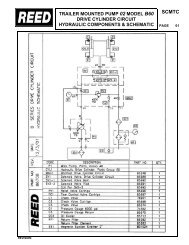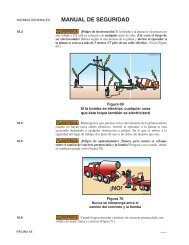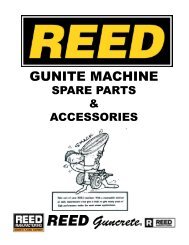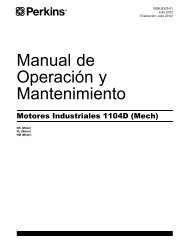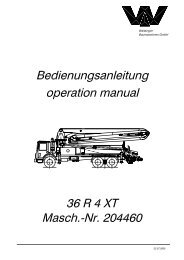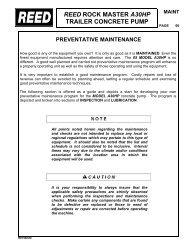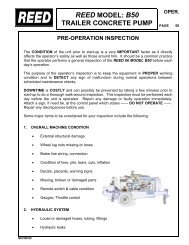Perkins Motor Operation and Maintenance Manual (English) - REED
Perkins Motor Operation and Maintenance Manual (English) - REED
Perkins Motor Operation and Maintenance Manual (English) - REED
Create successful ePaper yourself
Turn your PDF publications into a flip-book with our unique Google optimized e-Paper software.
SEBU8325-01 45<br />
<strong>Maintenance</strong> Section<br />
Refill Capacities<br />
<strong>Perkins</strong> recommends kinematic viscosities of 1.4 <strong>and</strong><br />
4.5 cSt that is delivered to the fuel injection pump.<br />
If a fuel with a low viscosity is used, cooling of the<br />
fuel may be required to maintain 1.4 cSt or greater<br />
viscosity at the fuel injection pump. Fuels with a high<br />
viscosity might require fuel heaters in order to lower<br />
the viscosity to 4.5 cSt at the fuel injection pump.<br />
Density<br />
Density is the mass of the fuel per unit volume<br />
at a specific temperature. This parameter has a<br />
direct influence on engine performance <strong>and</strong> a direct<br />
influence on emissions. This determines the heat<br />
output from a given injected volume of fuel. This is<br />
quoted in the following kg/m3 at 15 °C (59 °F).<br />
<strong>Perkins</strong> recommends a value of density of 841 kg/m3<br />
in order to obtain the correct power output. Lighter<br />
fuels are acceptable but these fuels will not produce<br />
the rated power.<br />
Sulfur<br />
The level of sulfur is governed by emissions<br />
legislations. Regional regulation, national regulations,<br />
or international regulations can require a fuel with<br />
a specific sulfur limit. The sulfur content of the fuel<br />
<strong>and</strong> the fuel quality must comply with all existing local<br />
regulations for emissions.<br />
In some parts of the world <strong>and</strong> for some applications,<br />
high sulfur fuels above 0.5% by mass might only be<br />
available. Fuel with a high sulfur content can cause<br />
engine wear. High sulfur fuel will have a negative<br />
impact on emissions of particulates. High sulfur<br />
fuel can be used if the local emissions legislation<br />
will allow the use. High sulfur fuel can be used in<br />
countries that do not regulate emissions.<br />
When only high sulfur fuels are available, it will be<br />
necessary that high alkaline lubricating oil is used in<br />
the engine or that the lubricating oil change interval<br />
is reduced. Refer to <strong>Operation</strong> <strong>and</strong> <strong>Maintenance</strong><br />
<strong>Manual</strong>, “Fluid Recommendations (Lubricant<br />
Information)” for information on sulfur in fuel.<br />
Lubricity<br />
This is the capability of the fuel to prevent pump<br />
wear. The lubricity of the fluid describes the ability of<br />
the fluid to reduce the friction between surfaces that<br />
are under load. This ability reduces the damage that<br />
is caused by friction. Fuel injection systems rely on<br />
the lubricating properties of the fuel. Until fuel sulfur<br />
limits were m<strong>and</strong>ated, the lubricity of the fuel was<br />
believed to be a function of fuel viscosity.<br />
The lubricity has particular significance to the current<br />
low viscosity fuel, low sulfur fuel, <strong>and</strong> low aromatic<br />
fossil fuel. These fuels are made in order to meet<br />
stringent exhaust emissions.<br />
The lubricity of these fuels must not exceed wear scar<br />
diameter of 0.46 mm (0.01811 inch). The fuel lubricity<br />
test must be performed on an HFRR, operated at<br />
60 °C (140 °F). Refer to “ISO 12156-1 ”.<br />
NOTICE<br />
The fuels system has been qualified with fuel having<br />
lubricity up to 0.46 mm (0.01811 inch) wear scar<br />
diameter as tested by “ISO 12156-1 ”. Fuel with higher<br />
wear scar diameter than 0.46 mm (0.01811 inch) will<br />
lead to reduced service life <strong>and</strong> premature failure of<br />
the fuel system.<br />
In case of the fuels which do not meet specified<br />
lubricity requirement appropriate lubricity additive can<br />
be used to enhance the lubricity of the fuel.<br />
Contact your fuel supplier for those circumstances<br />
when fuel additives are required. Your fuel supplier<br />
can make recommendations for additives to use <strong>and</strong><br />
for the proper level of treatment.<br />
Distillation<br />
This is an indication of the mixture of different<br />
hydrocarbons in the fuel. A high ratio of light weight<br />
hydrocarbons can affect the characteristics of<br />
combustion.<br />
Classification of the Fuels<br />
Diesel engines have the ability to burn wide variety<br />
of fuels. Below is a list of typically encountered<br />
fuel specifications that have been assessed as to<br />
their acceptability <strong>and</strong> are divided into following<br />
categories:<br />
Group 1: Preferred Fuels<br />
The following fuel specifications are considered<br />
acceptable.<br />
Fuels meeting the requirements that are listed in the<br />
table 16.<br />
“EN590-GradesAtoF<strong>and</strong>class0to4”<br />
“ASTM D975 Grade No. 1-D <strong>and</strong> 2-D”<br />
“JIS K2204 Grades 1, 2 & 3 & Special Grade 3”<br />
acceptable provided lubricity ware scar diameter<br />
does not exceed of 0.46 mm (0.01811 inch) as per<br />
“ISO 12156-1”.<br />
“BS2869 - Class A2 Off Highway Gas Oil, Red Diesel”



